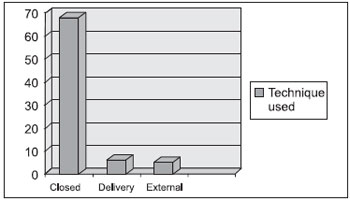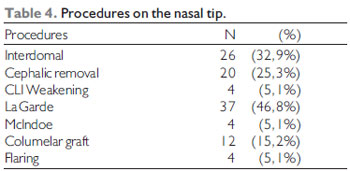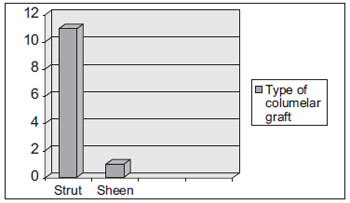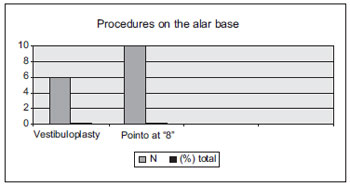INTRODUCTIONIn the end of the twentieth century, as the facial plastic surgery began to be more appreciated, ethnical and anatomical varieties were increasingly being discussed (1). At the same time, the concepts of beauty were reviewed and the diversity of statements and anatomic variations found became crucial for the choice of the technique to be employed in each case.
The objective of this study is to evaluate the techniques and maneuvers employed in the rhinoplasty operations carried out by the Otorhinolaryngology Service of the Clinical Hospital of the Federal University of Paraná during the year of 2007, by comparing them to studies performed in other regions of the country.
METHODRetrospectively, the surgical descriptions of 79 patients submitted to rhinoplasty in the Otorhinolaryngology Service of the Clinical Hospital of UFPR in the year of 2007 were evaluated.
For every surgery a form was completed and it comprised specifically: access incisions ; simultaneous performance of septoplasty; maneuvers on the osteocartilaginous dorsum, on the nasal tip, on the lower side cartilage; and the types of osteotomy cuts employed. In all patients, the surgeries were performed under local anesthesia with intravenous sedation.
The results obtained were organized in tables. The review included separately the kind of incision, procedures on the nasal tip, graft placement and osteotomy, on the total of patients operated, and obtained the prevailing techniques in our service.
RESULTSThe surgeries were performed by three approaches: closed (86%); delivery (6.4%); external (7.6%) (Chart 1).

Chart 1. Technique used.
As for the access incisions, the intercartilaginous incision was made in 78 (98.7%) patients, transcartilaginous incision in 7 (8.9%), marginal incision in 10 (12.7%) and transfixing incision in 76 patients (96.2%) (Table 1).
A high number of septoplasty operations was carried out (67 patients - 84.8%), simultaneously with rhinoplasty, aiming at the breathing function improvement. There was resection of the osteocartilaginous dorsum in 71 (89.9%) patients, dorsum graft placement in 4 (5.1%) patients (Table 2).
Lateral osteotomy operations were carried out in 77 (97.5%) patients and paramedian osteotomy in 19 (24.1%) patients (Table 3).
As far as the procedures performed on the nasal tip are concerned, they occurred in 47 (59.5%) patients; intermodal point was made in 26 (32.9%) patients; cephalic resection in 20 (25.3%); lower lateral cartilage weakening in 4 (5.1%); La Garde's operation in 37 (46.8%); McIndoe in 4 (5.1%) and flaring in 4 (5.1%) There was columelar graft placement in 12 (15.2%) patients, out of whom, strut was placed in 11 (91.6%) and in 1 (8.4%) the Sheen's shield was used (Table 4 and Chart 2).


Chart 2. Type of columelar graft.
As for the procedures carried out in the alar base, vestibuloplasty was performed in 6 (7.6%) patients and point at "8" in 10 (12.7%) patients (Chart 3).

Chart 3. Procedures on the alar base.
As in all surgeries, rhinoplasty demands a suitable exposure of the structures manipulated. Therefore, the incisions must be selected according to the structures to be approached. Patrocínio et al report that a specific and careful review of what is to be corrected is critical for a rhinoplasty. Tebbetts suggests we should use as many incisions as necessary for adequate structures exposure.
In this study, the basic technical rhinoplasty was mostly used in our service, covering 86% of all surgeries carried out. External rhinoplasty and delivery technique were performed respectively in 7.6% and 6.4% of the surgeries. Such fact differs from some national works; in 2006, Patrocínio et al reported an index of 71.1% of rhinoplasty surgeries with delivery and only 27.1% of basic technique rhinoplasty surgeries. We believe the reason for such difference is the target population for each study, and the great quantity of crossbred and negroid noses in that region In our service, we have found mostly Caucasian patients in whom the basic technique is proper for most of the cases.
The number of septoplasty operations (84.8%) simultaneous with rhinoplasty was high, aiming specifically at the breathing standard improvement and also serving as a graft material.
The lateral osteotomy was carried out in 97.5% of the patients, aiming at refining the osseous base and the closure of the roof of the nose. The osteocartilaginous dorsum resection occurred in 89.9% of the patients, aiming at the naso-frontal angle improvement; the dorsum graft placement occurred in only 5.1% of the patients.
Out of the procedures met on the nasal tip, the most used one was the accomplishment of La Garde's maneuver and intermodal point (46.8% and 32.9%, respectively), followed by the lower lateral cartilage cephalic portion resection (25.3%), columelar graft (15.2%). In a study mentioned above, Patrocínio et al reports a greater number of interventions on the nasal tip; with the lower cartilage cephalic portion resection in 58.4% of the cases; intermodal point in 45.1% and columelar graft in 45.7%. Such difference may also be explained by regional differences because in crossbred and negroid noses a major number of interventions for a better definition of the nasal tip is required.
CONCLUSIONThe rhinoplasty basic technique prevails in our service and therefore there is less need for techniques such as delivery and external rhinoplasty compared to services in other regions.
BIBLIOGRAPHICAL REFERENCES1. Westrid RW, Lawson W. The tripod theory of nasal tip support revisited: the cantilevered spring model. Arch Facial Plast Surg. 2008, 10(3):170-9.
2.Patrocínio LG, Carvalho PMC, de Souza HM, Couto HG, Patrocínio JA. Manobras cirúrgicas realizadas nas rinoplastias de um serviço de residência médica em otorrinolaringologia. Rev Bras Otorrinolaringol. 2006, 72:439-442.
3. Toriumi DM, Becker DG. Rhinoplasty Dissection Manual. Philadelphia: Lippincott Williams & Wilkins; 1999. p. 37-57.
4. Tebbetts JB. Primary Rhinoplasty. Saint Louis: Mosby; 1998. p. 61-86.
5. Daniel RK. Aesthetic Plastic Surgery - Rhinoplasty. Boston: Little, Brown and Company; 1993. p. 283-318.
6. Patrocínio JA, Mocellin M, Patrocínio LG, Mocellin M. Rinoplastia a céu aberto para correção do nariz tipo negróide brasileiro. In: Maniglia AJ, Maniglia JJ, Maniglia JV (editores). Rinoplastia: estética, funcional e reconstrutora. Rio de Janeiro: Revinter; 2002. p. 204-12.
7. Patrocínio JA, Mocellin M, Patrocínio LG. Rinoplastia no Nariz Negróide. In: Campos CAH, Costa HOO (editores). Tratado de Otorrinolaringologia. Volume 5 - Técnicas Cirúrgicas. São Paulo: Roca; 2002. p. 717-26.
8. Patrocínio JA, Patrocínio LG, Ramin SL, Souza DD, Maniglia JV, Maniglia AJ. Anestesia. In: Maniglia AJ, Maniglia JJ, Maniglia JV (editores). Rinoplastia: estética funcional e reconstrutora. Rio de Janeiro: Revinter; 2002. p. 62-8.
9. Sheen JH. Aesthetic Rhinoplasty. Saint Louis: Mosby; 1978.
10. Patrocínio JA, Sousa AD, Coelho SR. Incisões para inserção de implantes no nariz. Acta AWHO. 1986, 5(2):45-52.
11. Mocellin M, Maniglia JJ, Patrocínio JA, Pasinato R. Septoplastia Técnica de Metzembaum. Rev Bras Otorrinolaringol. 1990, 56:105-10.
12. Patrocínio JA, Patrocínio LG. Nariz em sela. In: Campo CAH, Costa HOO (editores). Tratado de Otorrinolaringologia. Vol. 5 - Técnicas Cirúrgicas. São Paulo: Roca; 2002. p. 727-38.
13. Patrocínio LG, Patrocínio JA. Uso de enxertos na rinoplastia. Arq Otorrinolaringol. 2001, 5(1):21-5.
14. Patrocínio LG, Patrocínio JA. Atualização em enxertos na Rinoplastia. Rev Bras Otorrinolaringol. 2001, 67(3):394-402.
15. Patrocínio JA, Madalena CA, Nonato S, Coelho SR. Complicações e dificuldades em Rinosseptoplastia. F.Med - Caderno de Otorrinolaringologia. 1995, 110(2):131-6.
1. Resident Doctor of Otorhinolaryngology for HC-UFPR.
2. Otorhinolaryngologist Medical Doctor.
3. Doctor. Professor of the Otorhinolaryngology Discipline of HC-UFPR.
4. Doctor. Head of the Otorhinolaryngology Department of HC-UFPR.
Institution: Clinical Hospital of UFPR.Register in the Ethics Committee of HC-UFPR under no. 1780.197/2008-09.Curitiba / PR - Brazil
Mail address:
Murilo Carlini Arantes
Rua Mariano Torres, 401 102
Curitiba / PR - Brazil - Zipcode: 80060-120
Fax (+55 41) 3360-6291
E-mail: murilocarlini@yahoo.com.br
Article received on August 25, 2008.
Approved on October 17, 2008